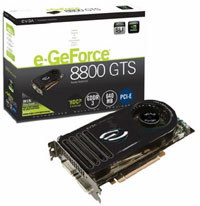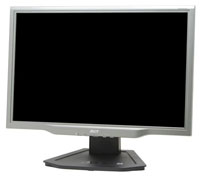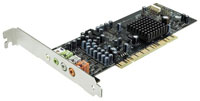Midrange Gaming Configuration
We've covered nearly all of the component choices necessary for a high-quality gaming solution already. The one major change that we would make would be to cut costs in most areas other than the graphics card, and then spend a large portion of the budget on getting a GPU that's as fast as possible. Here's what we came up with.
| Intel Mid-Range Gaming System |
| Hardware |
Component |
Price |
Rebates |
| Processor |
Intel Core 2 Duo E6300 (1.86GHz 2MB Shared) - Retail |
$185 |
|
| Motherboard |
Biostar TForce965PT (P965 775) |
$111 |
|
| Memory |
OCZ S.O.E 2x1GB DDR2-667 (OCZ2SOE6672GK) |
$221 |
$30 |
| Video Card |
eVGA GeForce 8800GTS 640MB (640-P2-N821-AR) |
$400 |
$20 |
| Hard Drive |
Seagate 320GB SATA 3.0Gbps 7200RPM 16MB (Barracuda 7200.10) |
$90 |
|
| Optical Drive |
LG Black 18X DVD+R (GSAH22N-BK) |
$36 |
|
| Case |
Cooler Master Centurion 534 (RC-534-KKN2-GP) |
$66 |
$10 |
| Power Supply |
Rosewill SLI 600W (RP600V2-S-SL) |
$73 |
|
| Display |
Acer AL2223Wd 22" 5ms (1680x1050) |
$314 |
|
| Sound Card |
Creative Sound Blaster X-Fi XtremeGamer 7.1 |
96 |
|
| Speakers |
Logitech X-530 5.1 70W Speakers |
$74 |
|
| Keyboard and Mouse |
Microsoft Comfort Curve 2000 B2L-00047 |
$28 |
|
| Operating System |
Windows XP MCE 2005 (with Vista coupon) |
$115 |
|
| Bottom Line |
|
$1809 |
$1749 |
 |
We pretty much took the base Intel midrange configuration and made several focused upgrades. The most significant change is going to be the inclusion of a GeForce 8800 GTS graphics card, and many people will be content to stop there. The GeForce 8800 GTS features DirectX 10 support (which of course will require Windows Vista and an updated public driver before it becomes useful) and it uses NVIDIA's new G80 core. We can't really evaluate DirectX 10 performance yet, but in currently shipping games the only single GPU solution that's faster than the 8800 GTS is the 8800 GTX. The GTS isn't a whole lot faster than AMD's X1950 XTX, and there are even a few games where it's slightly slower, but given the relatively similar prices and the improved feature set most gamers will prefer NVIDIA's offering right now.
 |
Besides the upgraded graphics card, we felt most gamers would appreciate moving to a larger LCD. We chose the Acer 22" LCD without HDCP support rather than the Sceptre we mentioned on the previous page, because many gamers really don't care too much about HDCP. We also added the larger 600W Rosewill power supply, and in order to get the most out of games we felt the inclusion of Creative's Sound Blaster X-Fi was warranted.
 |
Core 2 Duo generally does very well in gaming benchmarks, and anyone looking at doing even a moderate amount of overclocking will definitely get more mileage out of a Core 2 Duo chip. However, if you spend an equal amount of money on an AMD system, you can get an X2 4600+ that typically falls between the E6300 and E6400 in gaming performance (at stock speeds). Given the number of A-list games that currently benefit from multiple processor cores (all three of them!), you can even take things one step further and pick up a single core Athlon 64 3800+ to save even more money.
That said, we really hope 2007 will finally be the year where dual core processors begin to show more of a benefit in games. With such a high-end graphics card, the CPU could very well become a bottleneck, and several triple-A titles scheduled for the coming year look poised to put more of a strain on the CPU. While it might be interesting to contemplate using a single core processor with a high-end GPU in a gaming system, long-term that may prove to be a limiting solution and we don't recommend it.













43 Comments
View All Comments
vailr - Friday, January 19, 2007 - link
Intel doesn't offer any compelling single core solutions right now.Consider the socket 775 Celeron D 356. When compared with an older Northwood P4 CPU of similar speed [~3.3 GHz at stock speed], it would seem to be a very good price/performance ratio upgrade. Tiger Direct has it for $50, after a $20 MIR. Combine with a VIA chip based motherboard, such as the ASRock Dual-VSTA or ECS P4M800 (or similar VIA board), which can also still re-use older DDR memory sticks and AGP video cards. Might even make an interesting basis for an Anandtech review, showing the "best bang for buck" upgrades, for a 2 or 3 year old system.
Some Celeron D 356 owners have also had excellent overclocking results (past 4 GHz), depending on the motherboard used.
mino - Saturday, January 20, 2007 - link
When compared with an older Northwood P4 CPUWell, the problem is A64 3200+ goes for $60.
$5 cheaper than 356...
LoneWolf15 - Friday, January 19, 2007 - link
At which resolutions? At 1920x1200, I think the 8800GTS would be the clear winner.
Also, I'd be interested to know how much difference there is between the Creative X-Fi ExtremeGamer, and the similarly priced (well, compared to your review, online I've seen it retailing slightly higher) X-Fi ExtremeAudio. The ExtremeAudio has the nicer gold-plated jacks; the ExtremeGamer actually is the first Creative card that I've seen that allows a user to plug in standard Intel-spec front panel audio. The card layouts are so different that I'm sure there has to be more differences than that; I'd like to know what those are.
uofahoefx - Friday, January 19, 2007 - link
If you are comparing price/performance I think the X2 4200+ would have been a better starting point. The performance difference between the 3800+ and E6300 is too significant to compare these systems.KorruptioN - Friday, January 19, 2007 - link
Whether or not the Rosewill 600W is really that much better than the Fotron Source 450W is debatableIt really is. I did some research as to who really was the OEM for this particular 600W Rosewill, and it turns out that the OEM is Solytech (the UL label on the PSU says E223918, Googling that brings me to http://www.jonnyguru.com/SMPS_UL.htm">this list, which then tells me Solytech). These guys are the new image for Deer electronics. If you've been around the hardware world for a while, you might know that Deer PSUs a few years back were notorious for being fire hazards, nothing better than doorstops. I still wouldn't trust them today. I think it was a poor choice for your guide.
For $71, you can get a much better PSU. Antec's http://www.newegg.com/Product/Product.asp?Item=N82...">TP3-430 is a good choice, and you'd be saving money. It's a Seasonic build, so you can be assured of high-efficiency, low-noise, and good power.
Operandi - Friday, January 19, 2007 - link
Your right Rosewill sucks. This guide would have been better served having recommended the entry level 450 watt Forton across the board since nothing here would be able to break 300 watts DC let alone 600 (assuming the Rosewill could even reach that point which itself is doubtful).About the Antec TP3; it is built buy Seasonic but it has also had corners cut to reach that price point -- it is not equal to Seasonic's own units. If you want Seasonic build quality get a Seasonic (or PCP&C Silencer or Crucial) if you want the best PSU to $$$ ratio it has to be this 400 watt http://www.ewiz.com/detail.php?name=PS-E5140GH">Enhance.
JarredWalton - Friday, January 19, 2007 - link
Despite the hard stance a lot of "informed enthusiasts" take on Rosewill, actual testing of a 500W unit by http://www.jonnyguru.com/review_details.php?id=48">JohnnyGuru.com turned in very favorable results. This is the same site that disliked the high ripple on the OCZ GameXStream 700W, FWIW (but still gave it a good review). I continue to think people are judging Rosewill without having actually tested/used any of their products. Are their QC standards as high as SeaSonic or some of the other top brands? Probably not, but outside of perhaps higher than normal DOA parts (which you just send back and get a new, working unit), they work very well in our experience.yyrkoon - Sunday, January 21, 2007 - link
Now, it is not the one being talked about here, but just yesterday, another IT friend of mine, got in his new thermaltake water cooled system case, and used a 350W Rosewill PSU to power up the water cooling portion (thankfully for him, his system board hadn't arrived yet), and while testing the cooling system a loud *pop* came from the the PSU, followed by a small 'billow' of smoke( he thinks he probably blew the top of a capacitor off, but didn't bother to look). The PSU continued to work for another 15 minutes according to him, but who knows what would have happened if this was powering a full system.Yeah, a 350W PSU, would not be powering an i680 system board, with a E6600, and dual 8800GTX's (which will be his finished system), but this speaks a lot for the manufacturer IMHO. Also, I've rarely seen a PSU take out more than just itself when dying, but it does happen. In my buddies case here, he intends on this system lasting him another 4-5 years, so, having an in-expencive PSU in the mix is not an option. One last thing, JonnyGuru mentions himself, that even while the Rosewill PSU in question does perform admirably, the choice of capacitors use in it, is questionable. Anyone who has been building systems for a awhile must realize that when components die in a computer system, there is a very good chance, it is because of the caps used on one component, or another, be it system board, or PSU. I myself am a big fan of ABIT, and even have had a system board from them die after 5-6 years, because of leaking / bad caps . . .
mostlyprudent - Saturday, January 20, 2007 - link
I have been personally very disappointed with my Rosewill PSU. I bought a 400W version about a year ago to replace the generic 350W that came with the case I used for the general family PC. The Rosewill is louder and less stable. I had recently bought an Fortron Source 380W for my office PC for a few $ more than the Rosewill and have been extremely pleased.Just thought I'd share my personal experience for what it is worth.
yyrkoon - Friday, January 19, 2007 - link
DO you seriously think any reseller / system integrator would recommend such a PSU ? I wouldn't. Anyone can make sly connotations one way, or another, but the simple fact is, we here have a reputation to uphold when building systems for 2nd parties, and would NEVER recommend such a PSU. Now if a customers wishes to shave costs by buying 'lesser' components, we just make sure they're informed of the possibilities, and leave it at that. It is not like every single 'cheap' PSU is garbage, most work fine, it is the ones you don't know about that creep up and bite you in the ass.
Another way to look at it is, you just dropped $1000 on a system, that will hopefully last at least a couple of years, whats another $100-$200 on a good, proven PSU? Perhaps if your computer means very little to *you* there is no harm done, when and if if fails, but I personally like the assurance that whatever I buy will be the best for the amount of money I've spent, and simply put, none of those parts would be made by Rosewill. An external USB HDD case ? sure, ok, fine, but never a PSU.